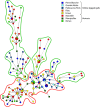Opportunistic fungal pathogen Candida glabrata circulates between humans and yellow-legged gulls
- PMID: 27782182
- PMCID: PMC5080578
- DOI: 10.1038/srep36157
Opportunistic fungal pathogen Candida glabrata circulates between humans and yellow-legged gulls
Abstract
The opportunistic pathogenic yeast Candida glabrata is a component of the mycobiota of both humans and yellow-legged gulls that is prone to develop fluconazole resistance. Whether gulls are a reservoir of the yeast and facilitate the dissemination of human C. glabrata strains remains an open question. In this study, MLVA genotyping highlighted the lack of genetic structure of 190 C. glabrata strains isolated from either patients in three hospitals or fecal samples collected from gull breeding colonies located in five distinct areas along the French Mediterranean littoral. Fluconazole-resistant isolates were evenly distributed between both gull and human populations. These findings demonstrate that gulls are a reservoir of this species and facilitate the diffusion of C. glabrata and indirect transmission to human or animal hosts via environmental contamination. This eco-epidemiological view, which can be applied to other vertebrate host species, broadens our perspective regarding the reservoirs and dissemination patterns of antifungal-resistant human pathogenic yeast.
Figures




References
-
- Khatib R., Riederer K. M., Ramanathan J. & Baran J. Faecal fungal flora in healthy volunteers and inpatients. Mycoses 44, 151–156 (2001). - PubMed
-
- Falagas M. E., Roussos N. & Vardakas K. Z. Relative frequency of albicans and the various non-albicans Candida spp among candidemia isolates from inpatients in various parts of the world: a systematic review. Int. J. Infect. Dis. 14, e954–e966 (2010). - PubMed
-
- Silva S. et al.. Candida glabrata, Candida parapsilosis and Candida tropicalis: biology, epidemiology, pathogenicity and antifungal resistance. FEMS Microbiol. Rev. 36, 288–305 (2012). - PubMed
-
- Krcmery V. & Barnes A. J. Non-albicans Candida spp. causing fungaemia: pathogenicity and antifungal resistance. J. Hosp. Infect. 50, 243–260 (2002). - PubMed
MeSH terms
Substances
LinkOut - more resources
Full Text Sources
Other Literature Sources
Medical

